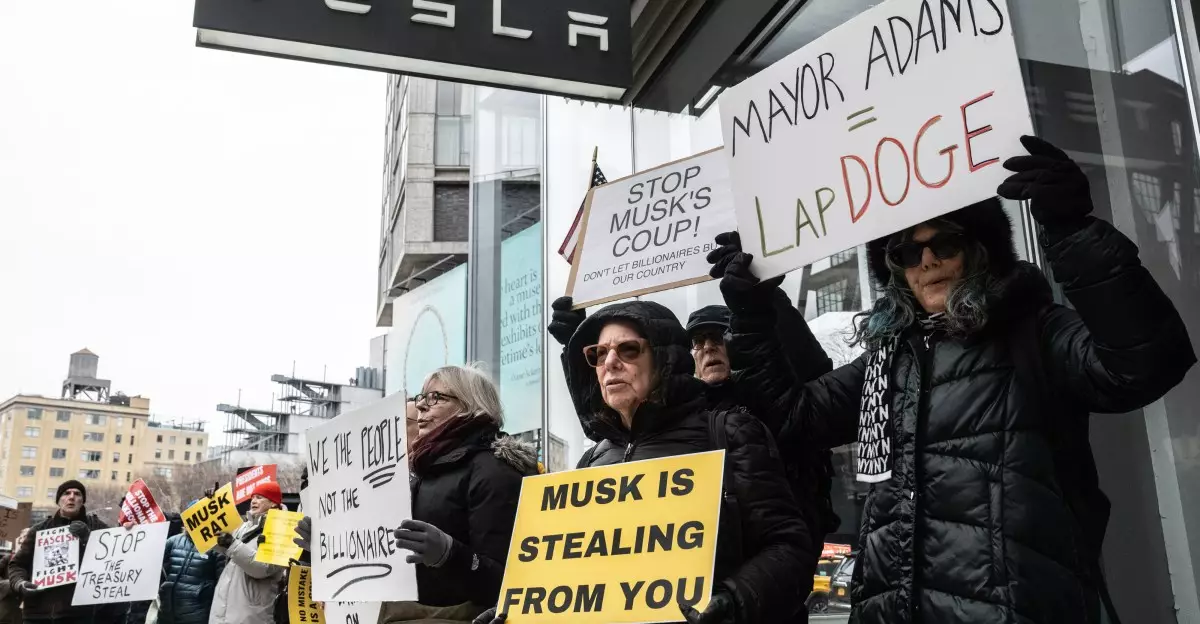In a wave of discontent reverberating across the United States, protestors have been mobilizing outside Tesla showrooms, marking a second weekend of demonstrations. The impetus behind this growing movement can be traced to the hashtag #TeslaTakeover, which has gained traction on various social media platforms, particularly Twitter’s emerging alternative, Bluesky. These protests, while not massive in scale, have been widespread, illuminating the frustrations of a diverse group of individuals united in their criticism of Tesla’s CEO, Elon Musk, particularly regarding his controversial role since the onset of Donald Trump’s presidency.
The protests are notable not just for their geographic diversity, stretching from New York to the suburbs of Golden Valley in Minnesota, but also for their pointed messages. Many protestors are voicing concerns over Musk’s perceived authoritarian tendencies and his financial impact on Tesla. According to sources, the company has seen its stock plummet over the past few years, a trend that Tesla investors have linked directly to Musk’s polarizing activities.
The internal atmosphere at Tesla appears to be marred by discontent, as reports reveal that many employees have expressed a desire for a change in leadership. A recent meeting involving senior staff culminated in sentiments that the company could flourish if Musk were to resign. This stark disapproval reflects a broader unease with Musk’s management style and decision-making processes, which some employees perceive as detrimental to the overall mission of Tesla—advancing sustainable energy solutions through innovative automotive technology.
These internal pressures are exacerbated by the external perception of Tesla as a whole. With the company at a crossroads amidst a stock price decline, employees are increasingly vocal about their fears that Musk’s behavior is adversely affecting brand loyalty and investor confidence. The results are a blend of frustration and insecurity within the workforce, which could critically impact the organization’s long-term viability.
The rhetoric used by protestors has been strikingly confrontational. For example, during a significant rally outside Tesla’s Manhattan showroom, chants such as “Don’t buy swasticars” surfaced, suggesting a direct critique of Musk’s affiliations with far-right groups and controversial comments. This overtly socio-political angle of the protests extends beyond mere brand criticism to a larger indictment of Musk as an individual. This narrative resonates particularly with those upset not only with Tesla’s practices but also with the moral implications surrounding Musk’s public persona.
Other protestors have leveraged different avenues to express their dissent. Notably, musician Sheryl Crow made headlines by sharing a symbolic gesture of having her Tesla removed via a flatbed truck, underscoring the necessity of aligning personal values with brand loyalty. Crow’s action echoes a broader sentiment, where consumers are increasingly willing to sever ties with companies over managerial ethics and social responsibility.
Looking forward, the continued organization of protests against Musk and Tesla indicates that this movement is far from a fleeting occurrence. Plans for future demonstrations are already being set in motion, with events scheduled around upcoming holidays and significant dates. This sustained momentum suggests that the public’s grievances with Musk are more entrenched than initially perceived.
As additional rallies blossom in cities across the nation, the influence of social media remains a critical tool for mobilization. While the hashtag #TeslaTakeover gains traction on platforms like Bluesky, its presence remains limited on mainstream outlets like X and Instagram, highlighting a division in how different communities engage with the narrative surrounding Tesla and Musk.
The ongoing protests against Tesla reflect a complex interplay of corporate leadership, political discontent, and the consumers’ desire for ethical alignment in their purchases. As stakeholders, including employees, investors, and customers, vocalize their discontent, the potential for significant change within Tesla looms large. The coming weeks may prove crucial in determining not only the future of protests but the company’s trajectory as it seeks to navigate the storm of public opinion directed towards its controversial leader. With rising scrutiny surrounding Musk’s governance, the question remains whether Tesla can maintain its status as a pioneering force in the automotive industry amidst a quagmire of ethical dilemmas and public discontent.

